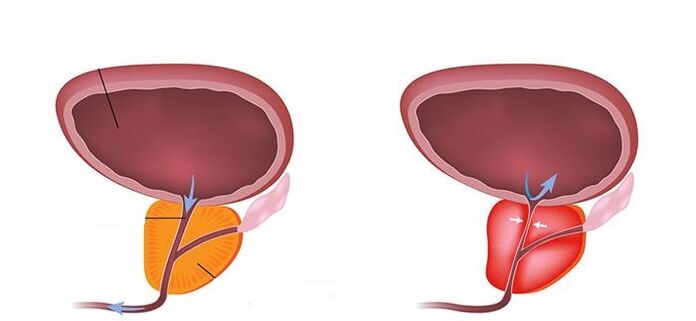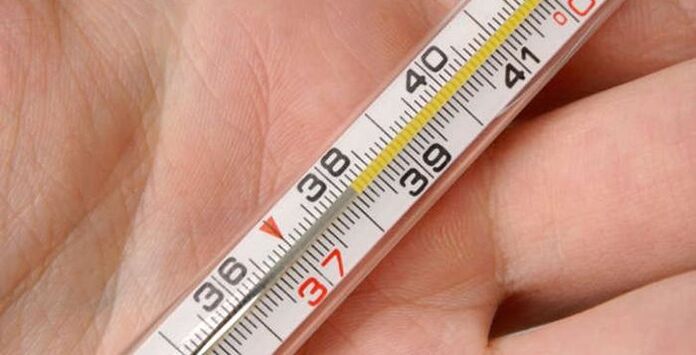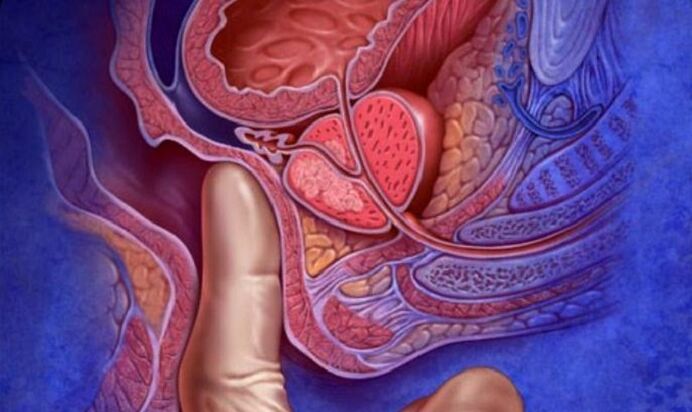According to statistics, one in three able-bodied men suffers from prostatitis at different stages of their lives. Persistent pain, impotence, infertility - this is not a complete list of problems that threaten patients in the absence of treatment. Because of the great urgency and danger of the disease, all its symptoms and initial manifestations must be known to all people. In this article, you will learn about all the signs and diagnostic methods that allow you to recognize prostatitis.

The clinical picture in the early stages of development
Prostatitis is an inflammatory lesion of the male prostate. The following forms of the disease are distinguished: acute and chronic bacterial prostatitis, chronic pelvic pain syndrome, asymptomatic prostatitis. Each form manifests itself in different ways, with its distinctive signs and characteristics on the track.
It’s hard to say how the disease will continue in every single man. The presence of certain signals depends on a number of external and internal factors. For the convenience of characterizing the pathology, it is customary to divide all the symptoms of prostatitis into 3 major groups: symptoms related to urinary disorders, sexual dysfunction, mental problems. The first and most significant symptoms of prostatitis (other than the asymptomatic form) may be the following signs in a man:
- Pain in the pelvis, back, groin area.
- Pain and burning when urinating.
- Difficulty urinating.
- Feeling of incomplete bladder emptying and false urination.

Pain in the pelvis, back, groin, a feeling of incomplete emptying of the bladder and a false urge to urinate are signs of prostatitis.
The listed symptoms are due to impaired urinary function due to the anatomical features of the structure and location of the bladder and prostate gland. Signs of prostatitis with sexual dysfunction are also significant and pronounced. Men most often make the following complaints:
- Weak erection.
- Ejaculation starts quickly during intercourse.
- Lack of orgasm or decreased sensitivity.
- Urethral and rectal pain during ejaculation.
Problems with urination and difficulties of intimate life due to inflammation of the prostate gland greatly disturb a person. Patients with prostatitis are forced to change their lifestyles, deny their habits, and family relationships become more complicated. Obsession with your problem causes increased nervousness, anxiety, decreased libido, which can also be called indirect signs of prostatitis, and which belongs to the third group of the above symptoms (mental disorders).

In men, prostatitis can often be confused with prostate adenoma or cancer, a pathology of the bladder. All of these diseases appear similarly, especially in the initial stages. It is very difficult to distinguish them for an unprepared person, so differential diagnosis is made by analyzing all existing objective symptoms, laboratory and instrumental research data. Because each form of prostatitis has its own signs and characteristics, these should be considered separately.
Characteristics of some forms of the disease
Acute prostatitis is an inflammation of the male prostate gland caused by the penetration of an infectious agent into the organ through the blood, lymph, or urethra. The disease begins abruptly and is characterized by the severity of all clinical symptoms. The main symptoms of acute prostatitis are:
- A rise in body temperature of 39-40 degrees.
- Symptoms of general intoxication (headache, weakness, fatigue, decreased performance, etc. ).
- Severe pain in the perineum, sacrum, above the human pubic joint.
- Frequent, painful urination.
- Sometimes men have urinary retention.

Temperatures 39-40 are a clear sign of inflammation of the prostate gland.
Acute inflammation of the prostate gland usually ends with the process being restored or chroniced (symptoms can interfere for several months). But more often, this form of prostatitis is primary and results from poor habits (alcohol consumption, smoking, etc. ), sedentary lifestyle, vitamin and mineral deficiencies, prolonged sexual abstinence, or ingestion of non-aggressive sexually transmitted infections or normal microflora. The clinical picture of chronic prostatitis looks weaker compared to the acute form, the symptoms of the disease are inconsistent, which makes diagnosis very difficult. The following symptoms are most common in the chronic form of prostatitis:
- Increased urination, also at night.
- Pain when urinating as well as ejaculating.
- Dull painful pain in the lower back, pelvis, above the chest, etc.
Chronic pelvic pain syndrome (CPPS) in a man combines recurrent pain in the prostate area, transient disorders of the urinary and reproductive systems. In medicine, CPPS is a broader concept because pathogenetically, pathology can be based on a tumor or ischemic process, disorders of the nervous system, and not just inflammation. The inconsistency in the presence of signs of prostatitis in chronic pelvic pain syndrome makes diagnosis significantly more difficult, but much more difficult to perform in asymptomatic form. In these cases, the main and decisive role is played by the data of laboratory and instrumental research methods.
Diagnostic techniques
A definitive diagnosis cannot be made based on the symptoms of prostatitis alone. In addition, physicians should collect a medical history: information on when symptoms appear, their relationship to major and significant life events, physical and mental shocks, clarification of all possible predisposing factors, and so on. A physiological examination is always performed - a digital rectal examination in the position of a sick male knee-elbow, with his legs bent at his side, or standing with his body bent forward. During this test, you may find symptoms characteristic of prostatitis (not all of which are required):
- Enlargement of the male gonad.
- The shape of the organ is correct or flattened.
- Dressed or doughy.
- Smoothness of the boundaries of the prostate gland.
- Increased pain with pressure.

Further investigation of patients with symptoms of prostatitis is complemented by laboratory methods. General and biochemical blood tests are prescribed - there are no specific changes in the indicators, only indirect signs that allow the assessment of the presence of the inflammatory process in the human body (increase in the number of leukocytes, acute phase proteins, accelerated) ESR). The results of urine tests will be valuable, allowing the assessment of the presence of the infectious process in the genitals, helping to determine the pathogen to start etiological treatment. In addition, urologists may require an analysis of prostate secretion, a spermogram.
The most informative method of diagnosing prostate disease is TRUS - transrectal ultrasound. In this case, a special sensor is used, which the doctor places in the rectum. This causes inconvenience to a sick person, but this is compensated by the information content of the method. TRUS can be used to assess organ structure, assess the presence of tissue inflammation, the degree of urinary tract stenosis, and rule out the presence of tartar. The main echoes of prostatitis are: increased organ size, edema, fibrosis, sclerotic tissue changes, coarse-grained, and heterogeneous structure.
In addition, patients with symptoms of prostatitis undergo uroflowmetry - a special diagnostic manipulation in which a man’s rate of urination is measured. Based on the data of this study, conclusions can be drawn about the degree of urethral stricture and detrusor activity. Uroflometry cannot replace TRUS, but confirms findings and signs of pre-existing prostatitis.
The plan for a diagnostic test for prostatitis can be expanded if indicated by a man. A cystoscopy, a CT scan of the pelvis, can be performed to clarify certain points regarding the diagnosis. In unclear cases, a biopsy is performed to differentiate with tumor processes.
What to do when the first symptoms appear
The biggest and most common mistake many men make when they have signs and symptoms of prostatitis is waiting. All patients hope that the unpleasant symptoms are temporary and will soon disappear. Untreated prostatitis is dangerous to health, leading to irreversible changes in the body that are fraught with a damaged erectile mechanism, infertility or, worse, a malignant tumor of the process (transition to cancer).
To prevent serious complications, at the first signs of prostatitis, every man should consult a urologist who prescribes treatment. First, men receive etiotropic therapy - they use anti-inflammatory drugs, antibiotics, and they take measures to strengthen the immune system. In the absence of complications, no surgery is required. Men who have a history of prostatitis are at risk and are likely to recur, so prevention plays a major role after recovery.



























